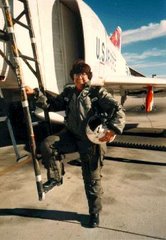Well, on Friday we almost had the Space Shuttle Orbiter drop in on us out of a clear blue sky. Literally. The sky here was clear and blue, while the sky at Kennedy Space Center, at Cape Canaveral in Florida, was gray and rainy. The Orbiter usually lands at KSC but it can’t be flown through rain (that erodes the thermal protection tiles on its underbelly) so NASA was looking seriously at bringing it in to Dryden, at Edwards AFB here. They don’t like to do this because it’s inconvenient and expensive and sets back the schedule. However, replacing all the TPS tiles would be vastly more inconvenient and expensive and would set the schedule back a lot more.
Besides, it’s Christmas. I’m sure this wasn’t a primary factor in their decision-making process, but it had to weigh in a bit. If the Orbiter had landed here in California on Friday, the entire recovery team would have had to fly out here immediately, since Dryden only has a skeleton crew to get the Orbiter safed and parked. Can you imagine having to find airline seats for a couple hundred people two days before Christmas, when the entire air transport system is nearly at a standstill because of the Denver blizzard? I don’t see how they could have done it; they probably would have had to ask the US Air Force for help. Now that would have been fun, a cross-country flight in a C-141 or C-17, for the recovery crew. A great way to start off a ten-day to two-week deployment away from home and family during the most family-oriented holiday season we have.
It’s not just the recovery crew that would have plans scrambled, but a lot of support people at Dryden and at Edwards. Normally, both organizations come pretty close to shutting down. There’s no flying, no meetings, just a small fraction of the workforce working, usually because the workers don’t have any annual leave or vacation time. It’s actually not a bad time to write a paper, because there are no interruptions, no meetings, no flights to support, or any other distractions. The most inconvenient thing about it is that the cafeteria is closed, so lunch comes in a brown bag, out of a vending machine, or at whatever is open over in the Base housing area. If the Orbiter had landed here, it wouldn’t have been like that at all. All the local people needed to support the recovery operation would have their holiday plans disrupted, as would their families, at the last minute. Some key people might even have been recalled from their holiday trips, via the snarled-up air travel system.
I’m certain that everyone breathed a sigh of relief when Space Shuttle management decided that the weather at KSC would give them a safe landing window. Sure, everyone would have stepped up and done their jobs out in California and families would have understood and accommodated the changes, but everyone has to be a lot happier that everything went as planned.
Still, I kind of missed hearing the distinctive BOOM-BOOM and seeing the big white Orbiter swooping down to land. Orbiter landings used to be kind of routine, as routine as I’ve seen a lot of Orbiter landings at Dryden, starting with the five Approach and Landing Test flights that used Enterprise. I think I’ve only missed four or five of the landings, usually because I wasn’t even in California at the time.








1 comment:
And I must post another comment here. I got a big kick out of reading about the shuttle. There were many aspects of its "care" that I was not aware of.
Gloria
Post a Comment